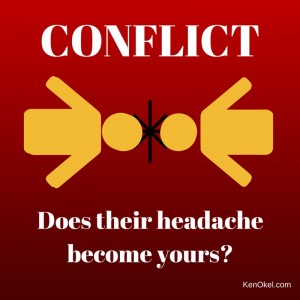 No matter your position, you may find yourself needing to be a leader when it comes to conflict resolution. This can be an unfamiliar distraction, where making the wrong choice could end up costing you a lot of time and create more problems.
No matter your position, you may find yourself needing to be a leader when it comes to conflict resolution. This can be an unfamiliar distraction, where making the wrong choice could end up costing you a lot of time and create more problems.
Let?s visit this scenario, which is from my TV news days:
Jane and Bob work at a TV station. Jane is a reporter and Bob is a photographer. The pair can spend up to 12 hours a day working together as a news crew.
Communication has broken down between them. While they avoid speaking to one another, they will go out of their way to tell others what?s wrong with the other person.
The conflict has created a burden for others. Productive time is wasted. When under deadline pressure, answerable questions from others is replied to with phrases like, ?Why don?t you ask him/her? That?s his/her job.?
You need to take action. You don?t have the ability to fire either Jane or Bob. Consider these scenarios, all of which I have witnessed, and their outcomes:
Ignore Everything
Allow the behavior to continue, unchanged. You?re thinking is that some people are like ice and fire and will never belong together. You urge the other members of the newsroom to make the best of the situation as both employees are needed.
The conflict between Jane and Bob will likely get worse. Other employees may resent you for your lack of action.
Pass It Off
You break up the Jane and Bob team and assign them to different photographers and reporters.
While this eliminates the conflict between Jane and Bob, as they hardly see one another anymore, it does have an impact on the existing crews.
Jim and Trevor have worked together for three years and could finish each other?s sentences. Now, they lose their close working relationship and have to start over with new colleagues.
There?s no guarantee that the switch will change Jane and Bob as their actions might have more to do with getting away with bad behavior, rather than the other person.
The Locked Room
Jane, Bob, and their supervisor all enter a room, with the understanding that they won?t leave until the conflict is addressed. There is no opportunity to delay a resolution.
Jane and Bob start off the session saying that the intervention is not needed. But their supervisor will insist upon it, saying that the organization as a whole is suffering from their actions conflict.
Within a few minutes of an intense and sometimes uncomfortable discussion, Jane and Bob realize that they like one another and enjoy their working relationship. They learn the root of their conflict is their long hours and pressure packed days. They?ve allowed little issues and misunderstandings to define their partnership.
On their own, these problems are minor but if left unaddressed, they start to pile up in their minds, fueling frustration.
Jane and Bob clear the air, recommit to their partnership, and never have another personality issue as a team.
Conclusion
The foundation of good leadership involves the willingness to invest time immediately, addressing a growing problem and not being afraid to enter a potentially uncomfortable situation.






